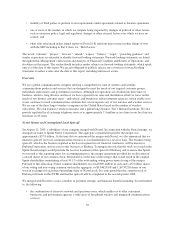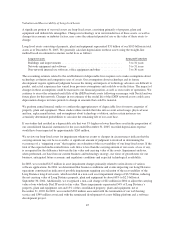Sprint - Nextel 2005 Annual Report Download - page 54
Download and view the complete annual report
Please find page 54 of the 2005 Sprint - Nextel annual report below. You can navigate through the pages in the report by either clicking on the pages listed below, or by using the keyword search tool below to find specific information within the annual report.In addition, a financial reconciliation is required to be completed in 2008 at the end of the reconfiguration
implementation, at which time we are required to make a payment to the U.S. Department of the Treasury to the
extent that the value of the spectrum rights received exceeds the total of (i) the value of spectrum rights that are
surrendered and (ii) the qualifying costs referred to above.
As required under the terms of the Report and Order, we have delivered a $2.5 billion letter of credit to provide
assurance that funds will be available to pay the relocation costs of the incumbent users of the 800 MHz
spectrum. Although the Report and Order provides for periodic reductions in the amount of the letter of credit, no
reductions had been made at December 31, 2005.
Long Distance
Through our Long Distance segment, we provide a broad suite of wireline voice and data communications
services targeted to domestic business and residential customers, multinational corporations and other
communications companies. These services include domestic and international voice, data communications using
various protocols such as next generation MPLS technologies, as well as IP, ATM and frame relay, and managed
network services. We also provide services to the cable companies that resell our long distance service and/or use
our back office systems and network assets in support of their telephone service provided over cable facilities.
We are one of the nation’s largest providers of long distance services and operate all-digital long distance and
Tier 1 IP networks.
For several years, our long distance voice services have experienced an industry-wide trend of lower revenue
from lower prices and competition from other wireline and wireless communications companies, as well as cable
companies and Internet service providers. In addition to increased emphasis on selling IP services, we are
converting existing customers from ATM and frame relay to more advanced IP technologies through a data
simplification initiative. Over time, this will result in decreasing revenue from frame relay and ATM service
offset by increases in IP and other data revenues.
Local
Our Local segment consists mainly of regulated incumbent local phone companies serving approximately
7.4 million access lines in our local service territories in 18 states. We provide local and long distance voice and
data services, including DSL services to customers in these service areas. We also operate a wholesale
telecommunications product distribution business.
For several years, we have experienced declines in the number of access lines that we serve in our local service
territories, as a result of competition from cable operators, which provide high-speed Internet services that can be
used as a platform to support VoIP and wireless providers, as customers completely forego the use of traditional
wireline phone service and instead rely solely on wireless service. The strategy of our Local segment to offset the
decline in access lines is to sell a bundled package of products and services to meet the needs of our consumers
and business and wholesale customers within our local service territories.
Critical Accounting Policies and Estimates
We consider the following accounting policies and estimates to be the most important to our financial position
and results of operations, either because of the significance of the financial statement item or because they
require the exercise of significant judgment and/or use of significant estimates. While management believes that
the estimates used are reasonable, actual results could differ from those estimates.
Revenue Recognition and Allowance for Doubtful Accounts Policies
Operating revenues primarily consist of wireless service revenues, revenues generated from handset and
accessory sales and revenues from arrangements with our wholesale operators and PCS Affiliates, as well as long
distance and local voice, data and Internet revenues.
43
























